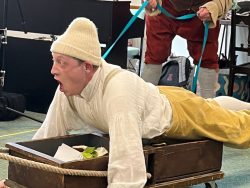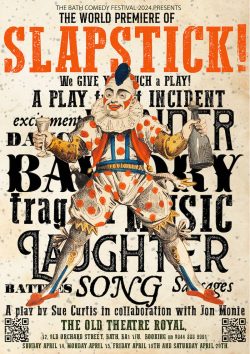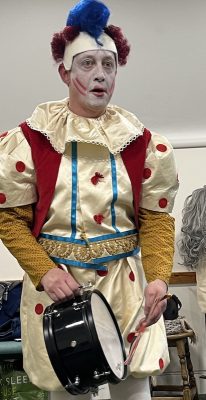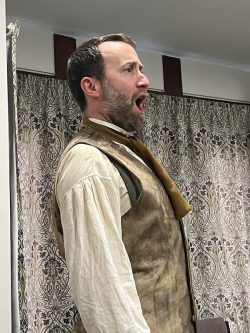 MOST theatre lovers and pantomime fans have heard the name Grimaldi and can possibly conjure up an image of the legendary clown, but know very little about the man or his life.
MOST theatre lovers and pantomime fans have heard the name Grimaldi and can possibly conjure up an image of the legendary clown, but know very little about the man or his life.
That all changes with Sue Curtis’s new play Slapstick, getting its world premier at this year’s Bath Comedy Festival. The play, written in collaboration with local actor and pantomime favourite Jon Monie during lockdown, is being staged in the Old Theatre Royal, now the local Masonic Hall, for seven performances between 14th and 20th April.
Jon Monie (of course) plays Joseph Grimaldi, born in London in 1778 into a family of entertainers with Italian roots. He became the superstar of the Regency stage, creating the tradition of the white-face clown whose interplay with the audience brought rapturous adulation and offered ethe perfect antidote to the mannered Shakespearean act-ors of the day.
But before he was famous, the child Grimaldi was all-but tortured by his drunken, lust-driven and cruel father Guiseppe, who was following in the footsteps of his own father, John Baptist Grimaldi, an Italian dentist and amateur performer who moved to England, and then back again when the going got tough and it was no longer possible to hide his antics from the authorities.
 Joseph quickly realised the intoxicating power of an appreciative audience and for a few years basked in the applause, but the death of his beloved wife and baby threw him into a gloom from which he never fully recovered. Although he remarried, Marie remained the love of his life and he could not forgive himself for allowing her and their baby to die in the agony of childbirth. To escape his demons, he created the clown Joey, and the audience at Slapstick is introduced to this prototypical funny man in all his irreverence, crudity, physical prowess and instant wit. His mimicry of a hated classical actor of the day is a joy to behold.
Joseph quickly realised the intoxicating power of an appreciative audience and for a few years basked in the applause, but the death of his beloved wife and baby threw him into a gloom from which he never fully recovered. Although he remarried, Marie remained the love of his life and he could not forgive himself for allowing her and their baby to die in the agony of childbirth. To escape his demons, he created the clown Joey, and the audience at Slapstick is introduced to this prototypical funny man in all his irreverence, crudity, physical prowess and instant wit. His mimicry of a hated classical actor of the day is a joy to behold.
Sue Curtis has researched not only the (recently well-documented) life of Grimaldi, but also of theatrical practices in his heyday. Not a fact in this fascinating comedy/drama/tragedy is invented, and she uses songs of the period and the clown’s own speeches.
The play is set on the (fictitious) night of his final performance, in London, when the expected members of the company have been waylaid by highwaymaen outside Sadler’s Wells (all true!), and Joseph is left with only his versatile but terrified stage manager and two drunken musicians to play all the characters who populated his life and career. Stories gory and extraordinary, sad, hilarious, bellicose, patriotic and ribald are enacted, with the help of quick-change costumes, tricks, the occasional puppet, and a bit of sleight of hand. The classic clown takes shape before our eyes.
 The pain and misery are as tangible as the jokes are bawdy. History, in the form of Napoleon and Nelson and the Royal Family, pass by as Grimaldi’s career burgeons. Long before the days of Health and Safety regulations, both the star and everyone else on stage was at risk of serious injury when the lifting tackle failed, or the stage hands failed to operate it properly. By the time he was 50, Joseph Grimaldi was physically broken. But his legacy endures.
The pain and misery are as tangible as the jokes are bawdy. History, in the form of Napoleon and Nelson and the Royal Family, pass by as Grimaldi’s career burgeons. Long before the days of Health and Safety regulations, both the star and everyone else on stage was at risk of serious injury when the lifting tackle failed, or the stage hands failed to operate it properly. By the time he was 50, Joseph Grimaldi was physically broken. But his legacy endures.
It is particularly interesting for the audience to see this illuminating show performed in the old Theatre Royal, which closed in 1805 when the theatrical action of Bath moved to the current site on Sawclose.
With Nik Holden as the stage manager (and several lovely damsels), Jools Scott, who is alo the composer of original music, and Harry Miller as the actor musicians, this is a play full of interest and action. There’s lots of talk about audience behaviour nowadays, but it is as nothing compared to the shenanigans of Grimaldi’s audiences.
 Jon Monie’s many fans will be delighted to see this accomplished actor, comic, singer and dancer explore his talents on home turf, and demonstrate that he is so much more than the (wonderfully funny and humane) knockabout he performs every Christmas in pantomime.
Jon Monie’s many fans will be delighted to see this accomplished actor, comic, singer and dancer explore his talents on home turf, and demonstrate that he is so much more than the (wonderfully funny and humane) knockabout he performs every Christmas in pantomime.
Tickets are available for the performances, which not only bring Grimaldi and his court to vivid life, but offer a glimpse of what theatre was in Bath at the turn of the 18th century.
GP-W
(Rehearsal photographs not taken at the Old Theatre Royal)